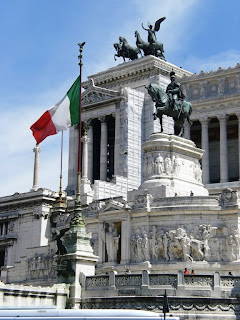A week in Rome, the Eternal City - it has so many things to see it could take an eternity to see them all. It's terrible, but after a while you walk past a 500 year old church and don't bother stopping - if it isn't 2000 years old then why bother? But doing that you miss the great art works of the renaissance, like the Caravaggios etc.
The Trevi fountain marks the meeting point of three roads (hence the name). It used to be the location where the acqueduct brought water to Rome from outside the city. The fountain itself was designed by Nicola Salvi (although he died before it was finished in 1762) and is the largest of the baroque fountains in Rome. If you throw a coin into the fountain it ensures your return to Rome (so the story goes). Apparently over 600,000 euros are collected from the fountain per year and given to charities.
Part of my seeming 'reconstruction tour of Rome', the obelisk at the top of the steps was being renovated. The 138 steps lead to the church of Trinità dei Monti.
This pretty tacky monument dominates the city skyline. It is a monument to the first king of the new Italy (in the 1870's). It looks like a wedding cake or typewriter and houses the tomb of the unknown soldier. It also has an interesting museum inside it outlining Italy's 140 year old history.
Behind the Victor Emmanuel monument is the Capitoline Museum. The square out the front was designed by Michelangelo. Most things in Rome were designed by Michelangelo or Bernini. The square houses a copy of this magnificent statue of the Roman Emperor Marcus Aurelius (he's the one who dies in the first few minutes of Gladiator). The original (above) is in the museum, with the she-wolf statue and thousands of roman busts and marbles.
The Forum was the meeting place of ancient Rome. The road through it (Via Sacre) lead from the Arch of Constantine right up the Capitoline Hill. Along the way is the Senate House, The Rostrum and several temples (including the Temple of Vesta where apparently the vestal virgins would keep the sacred flame alight - it was a 30 year job, but once they hit 40 they were 'released' with a large sum of money and could marry).
The Coloseum was completed in AD 80 and is actually called the Flaviam Ampitheatre. It could seat 50 000 people and was so well designed that it could empty in 15 minutes. It has since been used as a quarry for marble and the iron brackets have been stolen and melted down in the middle ages, leaving its surface pockmarked. As with most ancient roman buildings, the thing that probably saved it was its consecration as a church.
 Under the floor of the Colosseum. Here animals and gladiators could be elevated up through trap-doors to 'surprise' those in the arena.
Under the floor of the Colosseum. Here animals and gladiators could be elevated up through trap-doors to 'surprise' those in the arena.Probably the most impressive building from ancient Rome is the Pantheon. It was built by emperor Hadrian and resembles a greek temple. It is in a fantastic state of repair, again, because it was consecrated as a Christian church in the 7th Century. The domed roof is spectacular.











No comments:
Post a Comment